And Introducing on Guitar…
Meet the new members of our ragtag little band! Our brush goat herd got three new members this week: Story, a doeling; Dana, an Akbash pup; and Guru, a mature wether to put all these young ones in line! Thanks to our friend Mandy for generously contributing these animals to our project. The poison oak is disappearing as I write.
Story is four months old. She is half Kiko and half Nubian. She has a Disney princess face but don’t let it fool you. She’s ready to use those horns in the service of her independence. She’s curious about me and the bottle baby Ponder, but, like most goats, she likes for things to be her idea. So it goes better when she initiates. She trusts Guru and stays close to him, learning what to eat.
Akbash pup Dana has quite a story herself. She was part of an unexpected litter by one of Mandy’s Livestock Guard Dogs. As she was born with a deformed paw, Mandy was keen to place her well, offering her to us for free as part of various goat deals we discussed. I was resistant because, planning only four goats, I couldn’t imagine we’d need a second dog. But I never forgot this cutie and wished I could help. Mandy finally made us an offer we couldn’t refuse, and Dana came with these two goats. We’ll schedule some corrective surgery soon to declaw one digit where the claw curls under and hurts.
Unlike eight month old Tonka, who is very people oriented and interactive, Dana is a classic LGD, born with the herd, goat and dog focused. She doesn’t like human attention much but we’re working on that.
Dana’s already heavier than our adult Sheltie. And since she’s defiant of walking on a lead as yet, we often have to lug her around when outside the electric pen. Like Story following Guru as a kind of “Mini Me,” Dana scampers behind Tonka, learning her job between naps.
Because her focus has been goats and dogs until now, she’s having the classic LGD upbringing. But because her paw may limit her ability to do the job later in life, and because we have such a small herd and are very hands on with our animals, we want her to be well socialized to humans of all kinds. She might end up as a general farm dog or even a pet.
Consulting The Art of Raising a Puppy by the Monks of New Skete, I appreciate that she’s right in the middle of a critical period in her socialization with humans, especially strangers. We plan to give her opportunities to meet lots of people by taking her with us to the Plaza in Chico, where we go every Saturday for the Food Not Bombs public feeding. I expect her to be shy but it should pay off in the long run.
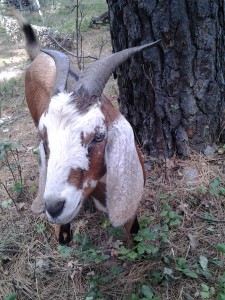
Guru is also a Kiko/Nubian mix. His ears move independently to bat flies, like two marionettes dancing.
Guru is the linchpin of the deal and the herd in general. I wanted a wether (castrated male) of some size and experience to bring Tonka’s exuberance under control and teach younger goats what to eat. Guru is a gravely serious sort, and is filling the niche nicely.
He’s easily twice the size of any of the pygmy goats I used to wrangle. And, being from a brush herd of seventy goats, he’s not used to a lot of human handling, other than for transport, getting shots, or other unpleasantness. So he’s been a handful, along with his apprentice in severity, Story.
We get along great in the pen. He and Story quickly ate pellets out of my hand and let me pet their muzzles, faces, horns, necks, and backs in progression over a day or so. But that first night when we went to corral them to take them to the barn, Guru wasn’t having it. We never did catch him and the entire herd spent the night in the pen. Many herds spend every night in the field, so this was okay, but since we have known predators about, I want them to sleep in the barn.
After taming him with pellets and touch throughout the next day, we were able to put leads on Guru and Story, so we can lead them to and from the barn. When they have bonded with us, they’ll follow off lead. Until then, each trip is a little easier and, even though he would deny it, his cries when I leave the pen let me know he, in fact, enjoys my company!
One more adult wether would complete our little herd. For now, we’re getting to know each other and establish a routine. The goats are eating the brush, including poison oak, which has meant that we humans are starting to get spots from the broken plants. No big deal so far.
Complications? You bet. Tonka didn’t like sharing his barn stall with ol’ big horns so he dug out. Leaving the light on has solved that. I forgot a utility box in the pen, which Story had learned to open with her horns. They helped themselves to grain and scattered other contents around their pen. C.T. pulled a muscle lifting the hefty pup and broke a blood vessel in his hand wrangling Guru by the horns.
Successes? Many! Two large foxes or small coyotes appeared at the pen and quickly trotted away when Tonka got down to business. Everyone respects the electric netting. Even Tonka, who shows no thought of trying to dig under it, as he did in the wire pen and the barn stall. Three of the landlord’s grandchildren came to visit the herd and the animals were curious and gentle.
That visit was a great beginning to socializing Dana, which continues today at the Food Not Bombs feed. Come on down!
—WT
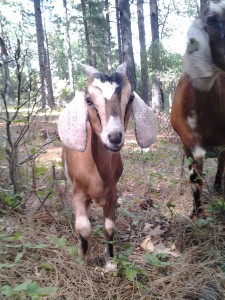
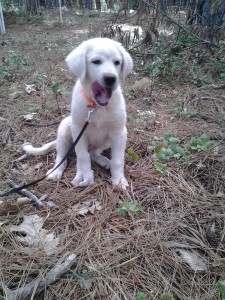
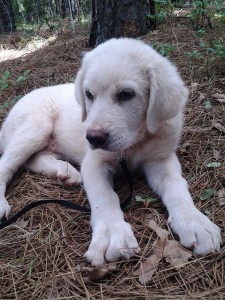
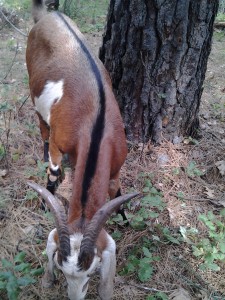
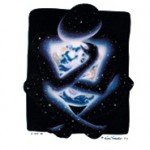
Leave a Reply
You must be logged in to post a comment.